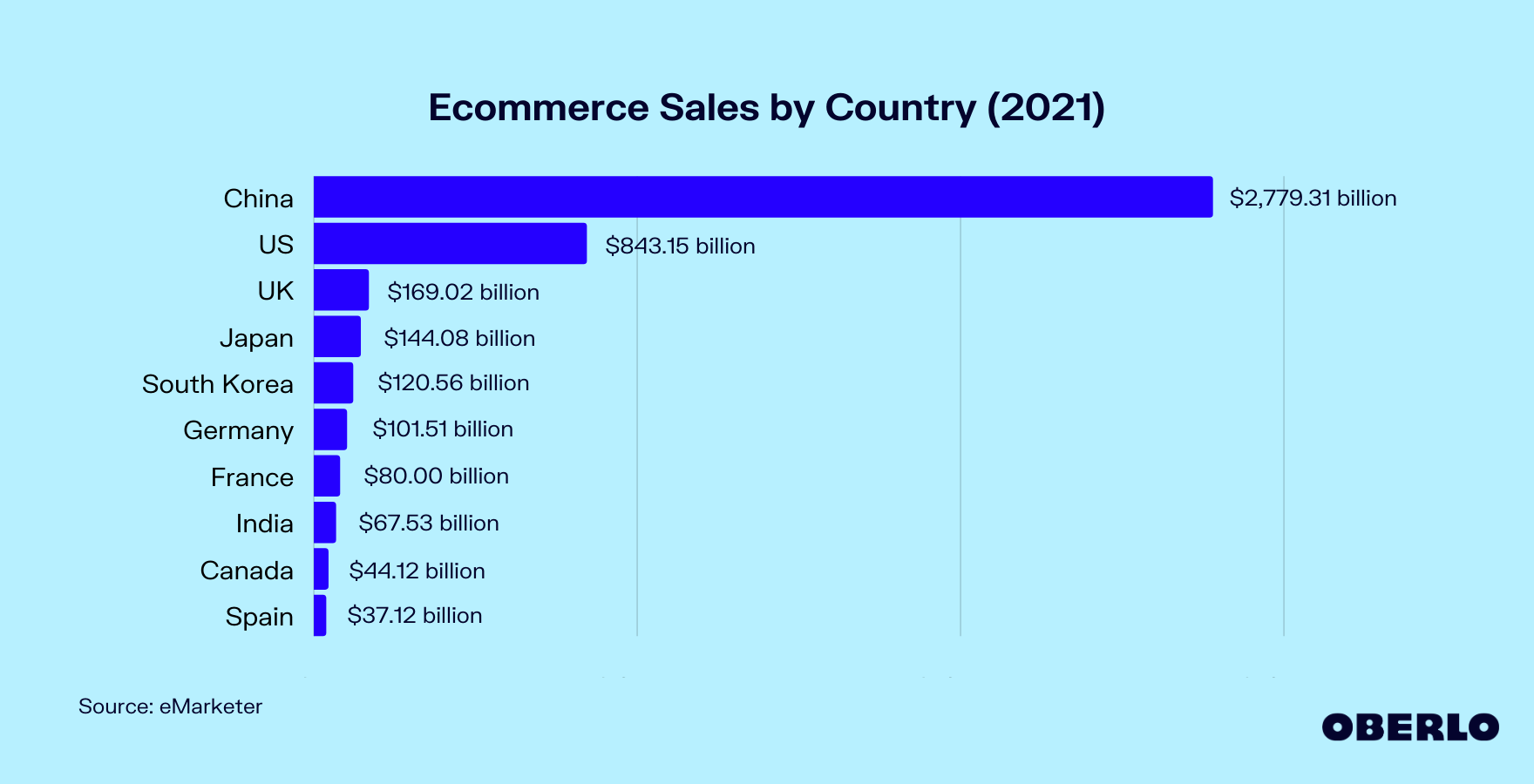Ecommerce is booming like never before.
Increased smartphone usage, better worldwide internet coverage, and the COVID-19 pandemic have led to the global rise of online shopping. Industry growth isn’t stopping anytime soon. Many consumers will not be going back to their old shopping habits, so it’s time to think about going global and localizing.
But, exactly where should you be expanding to? This post discusses the top 10 eCommerce markets to target in the next few years.
The World’s Top ECommerce Markets

1. China
China is now the biggest eCommerce market the world has ever seen. Alibaba and jd.com dominate the Chinese marketplace. Here are some astounding stats:
-
- In 2021, China contributed to more than half of the world’s retail eCommerce sales.
- There are an estimated 780 million internet users, and the number is growing.
- The eCommerce market in China is forecast to reach over US$ 3 trillion in 2024.
- Entering the Chinese market is now easier than ever before. The country is booming and is home to a wealthy class of consumers keen to get their hands on Western consumer goods.
2. The United States
The USA now ranks second in the global eCommerce market. ECommerce giant amazon.com leads the way in the United States. US online retail sales are projected to hit US$ 563.4 billion by 2025.
The US is a mature marketplace where eCommerce growth may slow in the years ahead. However, America still leads the Western world in eCommerce sales. The US eCommerce market size, advanced technologies, purchasing power, and absolute love for online shopping make it a hotspot for online sellers.
3. The United Kingdom
The eCommerce market of the United Kingdom is positioned at number three. ECommerce sales in the UK are forecast to reach more than US$ 119 billion by 2025.
Despite its small size, the UK is the most advanced eCommerce market in Europe. Revenues have grown by double digits in the last five years as this country of online shoppers has embraced the convenience provided by mobile access.
4. Japan
Japan is one of the largest and fastest-growing eCommerce markets. While B2B transactions initially dominated, the B2C market has doubled over the last decade. The country’s cross-border eCommerce market is forecast to reach US$ 3.4 billion by 2025.
The country is attractive for online sellers because of its developed economy, urban population, and almost nationwide internet access. Easy product delivery is provided by a robust and service-oriented business philosophy and advanced infrastructure.
5. South Korea
South Korea is among the largest eCommerce markets in the world. ECommerce revenue is expected to reach US$ 99.2 billion by 2025.
In 2019, South Korea became one of the first countries to launch commercial 5G network services nationwide. It is one of the world’s most technologically advanced economies, providing its population with the means to easily engage in online shopping.
6. Germany
Germany is a major eCommerce market and became the top country in the EU after Brexit. The country’s annual B2C online sales are estimated at almost $85 billion.
There are over 82 million high-income residents of Germany. Rather than being located in just a few cities, Germany’s industries are spread throughout the country. This means that you’ll find a strong industrial presence in several regions with high-performing sectors and eager consumers.
7. France
French eCommerce comes in at seventh in the world. ECommerce revenue in France is expected to grow to over USD 72 billion in 2025.
The French eCommerce market is characterized by a diverse consumer base, a high level of internet penetration, growing mobile services, reliable payment methods, and an efficient delivery structure. This market is a mature one, but it still offers ample opportunities for online brands.
8. India
India is a fast-growing eCommerce market with rising digital sales. India’s eCommerce market is expected to reach US$ 200 billion by 2026. Much of India’s growth is due to the increasing usage of mobile devices and the internet. Indians commonly buy personal care, beauty, and wellness items in their online purchases.
9. Canada
Coming in at number 9: Canada. Revenue in the country’s eCommerce market is projected to surpass US$ 40 billion by 2024.
For any eCommerce site, getting the customer’s order into their hands quickly and at a reasonable cost is a big part of the equation. In Canada, the country’s size and large areas that are sparsely populated can exacerbate the difficulty. The oft-mentioned barrier of high shipping costs is a challenge, but only in rural areas, as over 80% of Canadians live in relatively densely populated areas.
10. Spain
And last but not least: Spain. According to Statista market forecasts, the number of eCommerce users in Spain is expected to grow to 36.9 million in 2025. Spaniards have some of the highest smartphone usage in Europe, and this drives the eCommerce market. Trends show that Spanish consumers prefer fashion products and consumer electronics.
Tips for Launching in New ECommerce Markets
Now that you have a list of the largest and fastest-growing eCommerce markets in the world, here are some important tips for going global.
- Shipping:
Shipping is the lifeblood of global eCommerce. Consumers expect their goods to arrive in a timely way and at affordable shipping rates. - Fulfillment:
Working with wholesalers and suppliers in your targeted countries can significantly reduce shipping time and delivery costs. - Customs:
To avoid delays or your goods being held at customs, make sure you fill out your customs forms correctly without any errors. - Prohibited or restricted goods:
Become familiar with what you can or can’t ship to your chosen countries. - Addresses:
Make sure that your buyer’s address is correct before shipping. Failed delivery attempts will cost you time and money. - Insurance:
Cross-border shipping comes with risks. Make sure you are covered for possible losses with a good insurance policy. - Checkout:
Make the checkout process as seamless as possible for international users. Offer a variety of payment methods and accepted currencies.
ECommerce Markets: The Takeaway
Thanks to the Coronavirus pandemic, the early 2020s were challenging years across the globe. However, the pandemic accelerated the adoption of eCommerce everywhere, creating a new industry boom. ECommerce sales growth worldwide is projected to grow to 7.4 trillion dollars by 2025. And the growth rate continues to skyrocket.
Can you afford to miss out on your share of this revenue?
How Localize Can Help You Go Global
To be successful in any eCommerce market, you need the services of a top-quality translation and localization service like Localize. So choose your targeted countries and give us a call!







